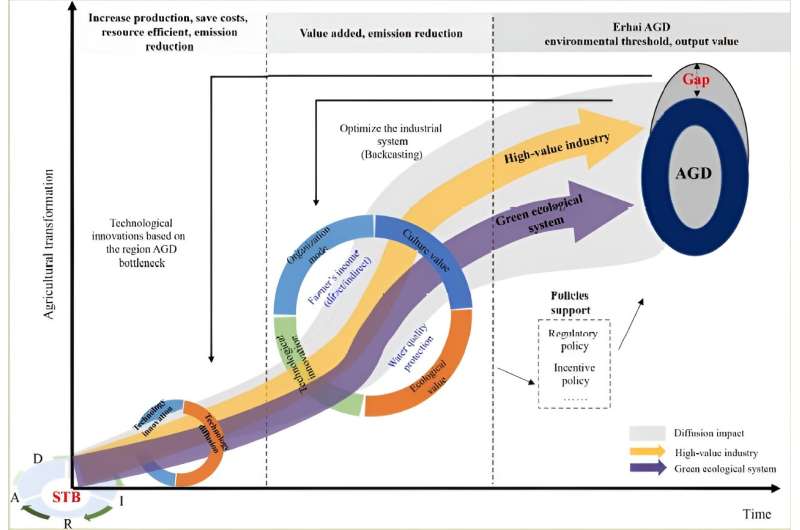This article has been reviewed according to Science X's editorial process and policies. Editors have highlighted the following attributes while ensuring the content's credibility:
fact-checked
proofread
A model to promote the coordination between environmental protection and agricultural development in Erhai Lake

Erhai Lake, covering 252 km2, located in Yunnan Province, is one of the seven largest freshwater lakes in China. However, over the last three decades, the lake has suffered pollution episodes. In order to solve this problem, the local government has taken many protective measures. These measures have achieved some results in the environmental protection of Erhai Lake, but also caused significant socioeconomic impact.
The tension between environmental preservation and economic stability in Erhai has even been termed the "Erhai dilemma." The "Erhai dilemma" is representative of those of other lakes in Yunnan Province and, more broadly throughout China. That is, how to harmonize environmental conservation and socioeconomic development.
In order to solve Erhai problems, Fusuo Zhang of China Agricultural University and his team rooted in Gusheng Village of Dali, through in-depth exploration of the complexity of "Erhai dilemma," put forward the adoption and promotion of Science and Technology Backyard (STB) model to promote the coordinated development of Erhai protection and farmers' income. The study has been published in Frontiers of Agricultural Science and Engineering.
The STB model in the Erhai Lake basin has established a collaborative platform. This platform convenes a diverse array of stakeholders, from local smallholders to scientific researchers and policymakers, to jointly design a systematic solution to the "Erhai Dilemma."
The STB has played a huge role in the coordination of ecological environmental protection and socioeconomic development. To pinpoint the origins of pollution, the STB designed a rigorous non-point source pollution monitoring network, colloquially termed the six verticals and seven horizontals system.
The results of the May–September 2022 survey showed that about 80% of the pollution was attributed to agricultural non-point sources. A more detailed breakdown showed that farmland contributed 35% to 55% and village sewage about 40% of the pollution.
Aiming to reconcile environmental preservation with economic prosperity, the approach began with a thorough investigation into the nutrient dynamics of different crops to strike a balance between supply and demand. The researchers then innovated green technologies and established an annual planting pattern that emphasized ecological and economic sustainability.
At the demonstration site, they observed significant agricultural and environmental benefits. Specifically, rice yields were boosted by 31% to 12,120 kg·ha–1 and profits soared by 23,850 CNY·ha–1, while phosphorus runoff dropped by 50% and COD by 52%. To ensure sustainable high-value cultivation with the goal of yearly financial goal of 150,000 CNY·ha–1, high-value crops such as multifunctional rapeseed and sweet corn were introduced in our innovative cropping systems.
Notably, the multifunctional vegetable-flower-oil rapeseed program delivered 20% and 19% reductions in phosphorus and nitrogen loss from farmland, respectively, a 50% increase in oil output, prolonged the flowering period by 10 days, and an extra 67,500 CNY·ha–1 profit through vegetable sales.
Since the establishment of the STB in Gusheng Village, its influence has extended beyond just facilitating green agricultural technological advancements. The socioeconomic impacts have been profound. Through research, it was found that the introduction of STB protocols and practices directly resulted in an estimated income increase of about 6.25 million yuan for the village, thereby raising the average annual farm income by 3395 yuan.
The Agricultural Green Development Program carried out in Erhai is an example of effective integration of environmental protection and agricultural innovation.
In conclusion, the Erhai STB initiative, by combining environmental conservation with green technology adoption and a strong focus on improving smallholder incomes, highlights the importance of ongoing research and adaptation in the pursuit of a more sustainable and prosperous agricultural future.
The long-term vision for the work envisions self-operation as farmers gain expertise and implement sustainable practices independently. Once a systematic solution is established and shared with local government, it can also provide a model for regions with similar problems.
More information: Coordinating environmental protection and agricultural development: a village-based case study for promoting green transformation, Frontiers of Agricultural Science and Engineering (2024). DOI: 10.15302/J-FASE-2024545
Provided by Higher Education Press



















